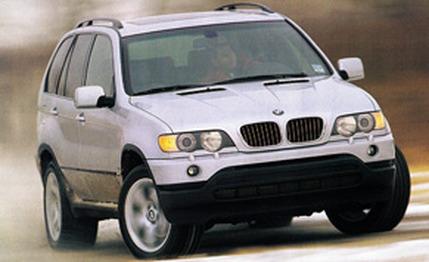 Road Test
Road Test
Our $55,315 Titanium Silver Metallic BMW X5 certainly looked the part of a means-business sport-utility vehicle -- square-shouldered, enormous 19-inch tires jamming the wheel wells, the prominent BMW twin-kidney grille. And as regular readers know, we like BMWs.
But early comments from staffers who drove this brand-new vehicle elicited very un-BMW-like, one-word adjectives -- such as jerky, jumpy, and jiggly. It sounded as if we were naming the cast of the "Seven Dysfunctional Dwarves."
Those comments were warranted especially on southern Michigan's grim washboard roads, where our X5, equipped with the $2470 Sport package, provided a downright punishing ride. Several of us wondered if somehow the tires had been inflated to, say, 60 psi. (They hadn't.) We wondered why the steering had such a stiff, slow, nonlinear feel. We wondered why the drive-by-wire throttle, entirely acceptable with this engine in the 540i sedan, had such an abrupt tip-in.
Then we thought: Hey, BMWs, presumably even its sport-utility vehicle (called by BMW a "sports-activity vehicle," for reasons that will become clear shortly), are road warriors, so let's take a road trip!
Four days and more than 2500 miles later, our first-impression complaints remained and were joined by a handful of additional shortcomings, although there were just as many nearly stellar achievements, because many of the good things about the X5 become evident with seat time. Suffice it to say that the X5, which gamely attempts to be all things to all drivers, isn't.
First, the good stuff.
The build quality of the unibody X5, manufactured exclusively in the BMW plant in Spartanburg, South Carolina, is on par with anything the company makes. Fit and finish was excellent. The X5 was drum tight on the roughest pavement and gave the impression it would still be so 75,000 miles down the road.
Similarly, there's little to fault about the X5's interior. Wood trim is used liberally on the doors, dash, and console. The leather used on the seating surfaces, door panels, steering wheel, and shift knob is top quality. The legible white-on-black instruments are properly framed through the top half of the steering wheel, which, incidentally, is fitted with buttons on the left side of the hub that control the stereo and ears on the right side that regulate the cruise control. There's a useful, unobtrusive trip computer, an excellent 10-speaker stereo, and three memory settings that store seat, seatbelt-height, steering-wheel, and outside-mirror positions.
Although the rear seats are a bit upright and thinly padded, the twin front bucket sport seats are superb. The driver's seat has an eight-way power adjustment; the passenger seat is six-way adjustable. That the driver's seat remained comfortable after a 24-hour stint behind the wheel is a significant achievement on BMW's part. Nice, too, is a huge dead pedal for the driver's left foot. As you would expect, safety features abound, including dual front and front side airbags, as well as the inflatable, sausage-shaped Head Protection System. Door-mounted rear side airbags are optional. Perhaps the most serious complaint about the passenger compartment is a minor one: The console-mounted twin cup holders can handle two cans but could not take two medium-size cups that flared at the top without tipping one of them off to the side.
Move to the rear, though, and our complaints get a bit more severe. With the 60/40 rear seats in place, luggage capacity is a modest 16 cubic feet -- the same as in a Hyundai Accent. If you want your cargo covered, capacity is reduced even more by a flimsy sliding plastic cover.
Beneath the cargo floor is, at least, a full-size spare tire -- although it was an 18-inch Michelin in our X5 that was shod with the 19-inch Bridgestones that come with the Sport package. The cargo door is a two-piece unit; the top section raises, and once it's up, you manually engage a switch (impossible to find at night unless you know where it's located) that releases the tailgate.